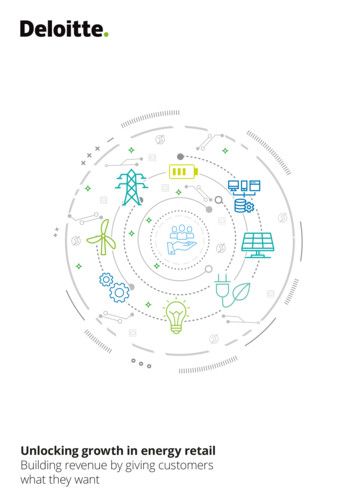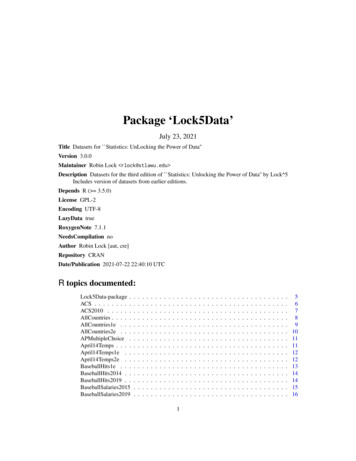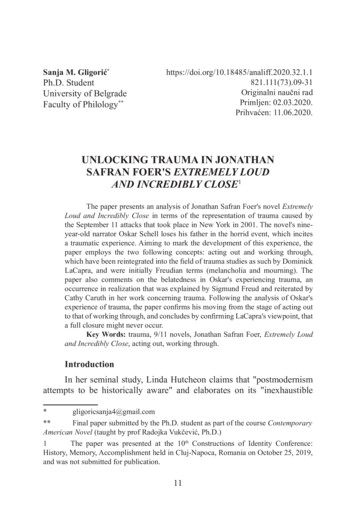
Transcription
Unlocking growth in energy retailBuilding revenue by giving customerswhat they want
ContentsIntroduction 03Part one: Where to play 04Part two: How to win 08Summary and next steps 12Contacts 13Endnotes 14
Unlocking growth in energy retail Building revenue by giving customers what they wantTo unlock growth in energy retail, utilities should drive their operationstoward outcomes their customers value, repositioning from energyproviders to solutions and services providers.There is considerable appetite among retail energy customers for anexpanded product and services offering from their utilities, accordingto our survey of 600 respondents across the United Kingdom, UnitedStates, Germany, Spain, Australia and India.Once utilities have a clear view of their ambition, opportunityand highest‑value customers, they can start to build the fivecore capabilities that will enable them to maximize the value oftheir customer relationships and transition into a sustainableEnergy‑as‑a‑Service (EaaS) business.IntroductionTraditional retail energy utilities1 in many countries face growingcompetition from new market entrants.Alongside competing more aggressively for fewer customers astheir traditional markets shrink, incumbents face an even‑greaterchallenge of repositioning for relevance in the transforming energymarket.PartonePart one explores where traditional utilitiesshould play, through repositioning theircustomer value proposition to deliversolutions and services, and the extentcustomers think utilities have the brandpermission to do this, based on marketresearch.ParttwoPart two looks at how utilities can winby building the business and technicalcapabilities that will enable them to evolveinto an innovative, agile and sustainableorganization.New digital and green energy retailers, telecoms and tech giantsare encouraging more retail energy customers to switch awayfrom their traditional suppliers with a growing list of enhancedin‑front‑of – and behind‑the‑meter services.To build value today and thrive in the future, energy retailersneed to maximize the value of their customer base by extendingtheir value proposition from a single product – electricity and gassupply – to innovating a broad portfolio of products and servicesthat incorporate a green dimension, while creating more value forcustomers.But how do traditional retail energy providers pivot from sellingenergy to focusing on customer value propositions? And howcan they equip themselves to sell new products and services totheir customers when it’s not always clear what those offeringsshould be?This paper is the first in a series on the future of energy utilities,exploring challenges and opportunities across the entirevalue chain, as well as the practical next steps to becominga future‑ready digital utility.This paper examines the practical next steps that will enable retailenergy providers to overcome these challenges and unlock growth.03
Unlocking growth in energy retail Building revenue by giving customers what they wantPart one: Where to playIn many of the world’s evolving retail energy markets, customer needs, attitudesand preferences look markedly different today compared with only a few yearsago.2 Increasingly, customers are looking to engage with companies whoseproducts and services help them to achieve their goals.3Businesses oriented around purpose can help drive theiroperations toward outcomes their customers value – for example,energy providers helping people reduce their carbon footprintthrough smart meters and renewable electricity.Businesses are using purpose to create deeper connections withconsumers, and opportunities for utilities to create new productsand services will only grow as energy markets (and customers’needs) continue to evolve. Figure 1 illustrates the shifts from thecurrent power market to the future.FIGURE B. CHANGES IN THE POWER MARKETFigure 1. ‘Changes in the power market’4Today’s Power MarketCentralizedPredictableVertically integratedTomorrow’s Power MarketOne onGenerationSelf healing NetworksElectric Power, gas,heat, onHome automationConnecteddevicesEnd customersSource:DeloitteSource:Deloitte analysis04Smart cooling& ncedmeteringinfrastructure (AMI)
Unlocking growth in energy retail Building revenue by giving customers what they wantDigital platforms in the retail energy sector are in their infancy interms of becoming enablers for energy providers to sell a rangeof products and services. Still, given the outlook for tomorrow’sretail energy market, utilities need to start evolving their businessmodels now and broadening their innovation programs, in somecases significantly, if they are to keep pace with disruption andposition for success.Disruptive innovation in the retail energy sectorRetail utilities can manage and implement their efforts to innovate– that is, create new, viable business offerings – as a portfolio ofactivities balanced across three ambition levels: core, adjacent,and transformational.5 At present, most retail energy companiestend to focus on core innovations only – making establishedproducts and services better, for example, by streamlining andautomating prices. This narrow approach overlooks both the risksand opportunities associated with adjacent “new‑to‑the‑company”innovations (for example, bundling energy with phone and internetplans) or inventing new transformational innovations (for example,developing software platforms that enable owners of rooftop solarpanels to sell electricity to their neighbors).6Doblin’s Innovation Ambition MatrixNew business models are emerging that aggregate customer‑sitedgeneration (i.e., rooftop solar panels) and energy storage(i.e., electric vehicle (EV) batteries or residential systems) to providea range of services to utilities, grid operators, and electricitycustomers – including peer‑to‑peer7 trading platforms andStorage-as-a-Service.8Sensor technology and wireless connectivity create opportunitiesto converge seemingly unrelated sectors. Could retail electricitybusinesses use smart meter data to provide insight intoa customer’s insurance9 risk profile (for example, is the customerhome during the day and thus at less risk for burglary)?Next-Gen: Energy-as-a-ServiceIntegrated energy managerTRANSFORMATIONALNetwork orchestratorNEWDeveloping breakthroughsand inventing things for marketsthat don’t yet existAdvanced:Extend the productAdvanced: Expand into newandADJACENTb serviceu s i n e s ranges linesEnergysupplycontractingEnergy mancecontractingEnergy performancecontractingbusinessinto energysupplyanddeliverydeliverycompany” ementandoptimisationADJACENTWHERE TO PLAY (MARKETS CUSTOMERS)These companies disrupted their industries by deliveringan attractive customer experience enabled by leading‑edgetechnology and simple, elegant processes. They have strong brandequity, bring ecosystems together, apply network effects, and havemany partners allowing them to deliver scalable solutions.Figure 2. Doblin’s Innovation ambition matrixEXISTINGRepositioning from energy provider to solutions andservices providerGiven the same trends that have disrupted retail, transport andconsumer electronics are coming to energy markets, utilitiesshould consider the characteristics that have enabled disruptorcompanies like Airbnb and Amazon to be so successful.COREOptimizing existing productsFFoundational:oforu n dexistinga t i o n a customersl :DigitiseU s e d icoregital asc capabilitiesatalyst and ductsfor forcurrentcurrent customerscustomersEXISTINGINCREMENTALNEWHOW TO WIN (PRODUCTS ASSETS)Source: Geoff Tuff and Bansi Nagji, “Managing your innovation portfolio,”Harvard Business Review, May 8, 2018, rtfolio.X‑as‑a‑Service comes to energyEaaS is an innovative business model for providing bundled energyservices, propelled by technological and financial developments.Unlike a traditional retail business model, an EaaS model makesmoney from a range of sources and is not limited to merelycharging a margin on electricity and gas provided to customers(see figure 1). Its chief benefit is the simplification of multifacetedservice offerings tailored to customers’ specific needs.Its distinctive features are:It is sold on a subscription basis.The customer pays only for what they consume (not forthe asset or servicing requirements to maintain it).The service provider funds the upfront costs.It is data driven.05
Unlocking growth in energy retail Building revenue by giving customers what they wantEaaS moves energy retailers from a “do everything” model to anecosystem of alliance partners, enabling utilities to strip out costand provide devices and assets that enable customers to managetheir homes and lifestyles better.EaaS offers demand management and energy efficiency services,facilitates adoption of renewables and other decentralized supplysources, and also optimizes the balance between demand andsupply. The ability to link multiple sites in a bundled servicepackage means that EaaS is easily scalable to include on‑andoff‑site energy supply solutions, including power purchaseagreements, and energy storage and management.For example, utilities could provide customerswith solar or battery storage – smoothing outthe capital customers have to spend – whileutilities can make money by selling power fromthose assets to the wholesale market. Further, byaggregating the generation and storage fromnumerous distributed energy systems to createa virtual power plant, utilities could expand theirasset portfolios and sell grid balancing services tothe network operator.Utilities are already taking steps along the path to EaaS.New Zealand’s electricity generation and electricity retailingcompany bundles power, natural gas, phone, and internet plans,offering its customers competitive rates and the convenience ofa single bill. Spain’s Iberdrola10 signed an alliance agreement witha German car manufacturer, to supply and install home chargingpoints for customers of the carmaker’s new EV range. UK utilityScottishPower11 – owned by Iberdrola – launched a similar EVcharging solution in 2018. France’s Engie12 partnered to createFrance’s first smart region in a consortium, including water andwaste utility SUEZ.As the EaaS model evolves, utilities can expand the services andvalue they provide customers using a platform model that deliversSolutions‑as‑a‑Service.Here the utility owns the platform through which it can facilitateand integrate offerings from a large number of other serviceproviders. In the same way Apple develops few of the apps sold onits App Store, the utility does not own the products and servicesavailable on the platform but instead creates and facilitates themeans of connection between their customers and third‑partyproviders.06Platforms should enable energy and transaction management,operations and maintenance, and optimization of all appliancesand devices.Significant appetite for an expanded offeringfrom retail energy utilitiesThere is considerable appetite among existing retailenergy customers for an expanded product andservices offering from their utility that helps lessentheir impact on the environment, according to oursurvey13 of energy utility customers in Australia,Germany, Spain, UK, India and US.Of the survey’s 600 respondents, more than86 percent said they would be interested orhighly motivated to minimize their impact on theenvironment and global warming through reducingtheir energy use (figure 3).A high proportion (over 66 percent) said they wouldlikely pay more to ensure their energy supply comesfrom renewable sources (figure 4).Installing smart home devices was the most popularproactive change respondents would make toreduce their impact on the environment and globalwarming, followed by installing photovoltaic (solar)roof panels. 15 percent of respondents wouldconsider changing their vehicle to an EV (figure 5).A high percentage of respondents would beinterested in their energy utility providing specificproducts and services: 32 percent in solar roof panels,27 percent in renewable heating systems, 24 percentin battery storage systems and 17 percent in electricvehicle charging tariffs (figure 6).Cost is seen as the greatest barrier to minimizingimpact on the environment, followed by respondentsnot being able to find a product or installationservice they could trust (figure 7).
Unlocking growth in energy retail Building revenue by giving customers what they wantFigure 3. The extent which customers want to minimize theirimpact on the environment and global warming throughreducing their energy useFigure 6. Products or services customers would be interested intheir energy utility providing35%30%25%20%15%10%5%0%14%33%32%Solar roof panelsI am interested24%Renewableheating systemsBattery storagesystems17%Electric vehiclecharging tariffsProduct or serviceSource: Deloitte analysis53%It’s not a priority for me27%I am highly motivatedSource: Deloitte analysisFigure 7. The perceived barriers customers need to overcome tominimize their impact on the environment and global warmingFigure 4. The likelihood of customers willing to pay more toensure their energy supply comes from renewable sources tominimize their impact on the environment and global t23%Finding a productand installationservice you can trustLack ofinformationHassle, not enoughtime in the dayBarrier to changeSource: Deloitte analysis45%Not at all likelyNot very likelyQuite likelyVery likelySource: Deloitte analysisFigure 5. Proactive changes customers would make to theirhome and ways of working to minimize their impact on theenvironment and global warming30%25%20%15%10%5%0%25%22%20%Smart‑home PhotovoltaicRenewabledevices (e.g.(solar) roof heating systemslighting,panels(e.g. air‑sourcethermostat,heat pumps,security camera,ground sourcedoorbell)heat pumps,biomassheating etc)Item to change18%15%BatterystoragesystemsChange mycar to anelectricvehicleOnce utilities have identified their sources of value for growth,essentially where they choose to play in the market, they need towork out how to focus on customers, draw value from them andshare information from the ecosystem of partners they develop.The process of repositioning will require utilities to make somedifficult choices on where to play and where to allocate resourcesto preserve their core client base as they transition througha period of intensified competition, uncertainty and reinvention.Source: Deloitte analysis07
Unlocking growth in energy retail Building revenue by giving customers what they wantPart two: How to winThe transformation of a retail energy provider’s offerings should follow externalmarket developments and the expansion of internal capability.Once utilities have a clear view of their ambition, opportunity andtarget customer, they should build operational excellence in thefollowing core capabilities that will enable them to maximize thevalue of their customer relationships.1. Increasing customer lifetime value throughanalyticsTo maximize customer value, retail energy providersfirst need to identify and understand their high potential valuecustomers, what those customers need, the solutions andservices they can sell those customers and, behaviorally, theresponsiveness of those customers to messaging and campaigns.Energy utilities able to gather that insight can be very targetedin how they market, and sell to, their highest potential valuecustomers.This insight is generated through analytics based on data froma range of different source systems. These might be internalsystems – such as billing, customer relationship management(CRM), marketing campaigns, and financial – and external datasources, for example, mortgage data identifying people who havesold their house and are likely to transition to new suppliers.Once these insights have been analyzed and scored, utilities needto tie that into operational activity. This can range from businesscommunications (such as personalized online advertising andoutbound marketing campaigns, and next best action campaignsfrom call centers), to designing and developing new customer‑ledoffers.By taking a coordinated approach such as Customer ValueManagement (CVM), utilities can gain a deep understanding ofthe needs and behaviors of attractive customer segments, theirappetite for new services and overall profitability to determine anactionable plan that will ultimately lift revenue and drive growth.CVM focuses on four main building blocks to identifycustomer value and build value from the core todrive a growth strategy.IDENTIFY for Valueby assessing the opportunity sizeand determining where to targetCREATE for Valueby establishing the operating modelthat businesses will need to secure andhelp grow customer valueIDENTIFYfor ValueCREATEfor ValueDESIGNfor ValueSource: Deloitte analysis08ENGAGEfor ValueENGAGE for Valueby delivering the right offers at theright time via the most appropriatecustomer engagement channelsDESIGN for Valuewith customer led offers that areconstantly adapted to understandwhat works, why and with whom
Unlocking growth in energy retail Building revenue by giving customers what they wantTo increase customer lifetime value through analytics, retail utilitiesneed to build several new capabilities.1The first is around accessing data, structuring analyticsmodels, and turning data analyses into usable businessinsights.2The second capability is connecting these insights intobusiness operations to change both how they communicatewith customers and how they respond quickly totheir needs.3The third is coming up with the concepts for new productsand services, rapidly testing and launching them quickly tomarket, and scaling the successes. Many traditional retailutilities lack these capabilities, given their history of sellinga single product – energy – with tariff pricing being the onlychanges offered to customers each year.Retail utilities should adopt a disruptor’s approach to businessmodel innovation and value realization. Disruptors obsess withaddressing a clear customer or market need with a coherentapproach that addresses this need faster, cheaper and with greaterimpact on customer experience.2. Organizational flexibility and scalability toenable innovationMost traditional retail energy providers have anorganizational structure that seeks to service predictable customerhabits and known competitors – a model that performs poorly intoday’s highly‑competitive and increasingly interconnected marketwhere technology continually disrupts business models.In response to changing market conditions, retail energy utilitiesshould evolve their organizational structure to a model thatswaps predictable efficiency for flexibility and scalability to enableinnovation. Small, networked teams with resources, real decisionauthority and autonomy balanced by strict accountability can solveproblems end to end. They will generally be ‘faster to market’ thanheavily structured groups that require approvals before each stepor that rely on knowledge siloed within other teams or individuals.A music streaming service that currentlyemploys over 3,500 people serving124 million subscribers across 79 markets,attributes its success and rapid growth toits organizational flexibility and scalability.The basic organizing unit is a “squad” –a small, cross‑functional team designed tofeel like a mini‑start‑up. Each self‑managingsquad is organized around a clear customeror product outcome, and has the skillsand tools needed to design, develop, test,and release to production. The squadstructure achieves autonomy withoutsacrificing accountability for results,and for the actions that deliver them.Squads – the primary centers of innovation– are organized into a tribe – a collectionof squads that work in a related area.Competencies are linked and shared acrosssquads through Chapters and Guilds.Many other organizations globally are now structuring themselvesalong similar lines. While not all of these choices are appropriatefor energy retailers, its lessons are directly relevant. A more flexibleorganizational model focuses the entire company around unmetcustomer needs and desires to meet market demand, capture andsustain competitive advantage, and deliver customer value andbusiness value.This new model of cross‑functional teams organized by specificoutcomes is adaptable to disruption in the market, infinitelyscalable as the business grows, and capable of competingeffectively in a complex environment.09
Unlocking growth in energy retail Building revenue by giving customers what they want3. Architecting technology to enable business agilityTechnology is a core component to most businessestoday and at the heart of any business transformation.Harnessing big data and powerful cloud solutionscan overcome myriad infrastructure, platform, data,risk, and compliance challenges. Real‑time data flowswill enable participants, from generators down toconsumers, to make sense of what is happening.For example, big data will enable system operators tobalance energy flows by using weather informationto forecast changes in wind and solar generation, bylocation.Architecting technology systems that allow controlled, secure, easyaccess to data is a critical enabler for retail energy providers toincrease their customer lifetime value, digitize their core businesscapabilities, foster alliances and enable business agility.There are already many companies, both new digital andincumbent energy retailers, building their technology architecturein a digital platform model to facilitate new, innovative services andproducts for their customers.A fast‑growing UK based energy supplier has developeda cloud‑based energy platform for interacting with both customers(via the web, mobile and smart‑meters) and the industry (via, forexample, data flows, consumption forecasting, trading on thewholesale market). We are also starting to see energy supplierslicensing their innovative digital platforms to competitors viaa Software‑as‑a‑Service model.Traditionally, businesses have often invested in monolithic,end‑to‑end enterprise systems which enable business stability– when successfully implemented. However, these systems canobstruct business agility, require several years to implement fully,are often difficult to change once installed, and limit access acrossdifferent systems – where data is held in proprietary databases.A different approach is to implement a mixture of differentbest‑of‑breed technology solutions in a way that enablesbusinesses to custom‑build functionality, configure bundledproducts, introduce new products and services quickly, andimplement changes rapidly.Retail energy utilities can assemble a flexible suite of thesebest‑of‑breed capabilities tailored to their business model.For example, they might implement a packaged CRM applicationthat integrates with wider industry solutions, such as billing andindustry process management.In contrast to monolithic architectures – where processes aretightly coupled, and complexity limits experimentation andimplementation of new ideas – microservices architectures makeapplications easier to scale and faster to develop, enabling quickintegration of new features and functionality.With configure price quote (CPQ) solutions, retail energy providerscan move away from traditional to flexible consumption‑basedapproaches. CPQs offer greater efficiency, sophisticated offeringswith multiple features, and improved pricing structures with theflexibility to set discounts and margins at various levels.Tools like application programming interfaces(APIs) enable businesses to use previouslyisolated data sources in valuable new wayswhile keeping their legacy systems running.The quality of data‑driven insights will onlyincrease as energy utilities and their customersincorporate Internet of things (IoT) sensors,web and mobile apps into their daily routines.By developing both public and private APIs,energy utilities can integrate with third partysolutions, improve products, systems andoperations, and create new ways to engage andconnect with customers.10A well‑designed CPQ process shortens the sales cycle andreduces inadvertent quoting errors by integrating internal systemswith external partners in the sales cycle, and defining steps toauto‑validate and auto‑book incoming orders.4. Fostering alliances and partnershipsRetail energy providers need an expanded ecosystem ofsuppliers and alliance partners to increase their abilityto innovate, turn on new technologies, and bring new productsand services to market quickly. In part, this is an extension of whatutilities do now from a supply management perspective with, forexample, existing technology vendors selling CRM solutions oranalytics platforms.
Unlocking growth in energy retail Building revenue by giving customers what they wantHowever, through a partnership model, more and more businessesare going to be assembled – partnering with other organizationsto access and offer their products and services rather thandeveloping them in‑house. In this way, utilities can compilecapabilities from numerous different start‑ups or technologies andrebrand them to sell to the market.For example, a service currently being trialledby a UK based energy supply company inpartnership with Nissan, enables retail customersto store electricity in their EV battery whenits cheapest then sell it back to the grid whendemand and prices for electricity are high.To partner successfully, utilities require the ability to managethose alliances: quickly integrating and connecting with a range ofexternal partners.As we explored in the EaaS model, utilities can expand the servicesand value they provide customers using a platform model thatdelivers Solutions‑as‑a‑Service.Sensing is a key enabler foradjacent and transformationalinnovations, and utilities thatcan make sensing a part ofhow they manage innovationwill keep their businessesmoving forward.5. Sensing and tracking broader technology,innovation and retail trendsSensing is looking for the next round of new productsand services – the ability to sense what is going on throughcustomer and market research, monitoring new technologies (andhow to apply them) to improve products and services continually.Sensing is a key enabler for adjacent and transformationalinnovations, and utilities that can make sensing a part of how theymanage innovation will keep their businesses moving forward.An example of this sensing capability might be monitoring thedevelopment of 5G and figuring out its applications for a retailenergy provider.Utilities might monitor other sectors for cross‑fertilization of ideas.The insurance sector, for example, has witnessed a high‑switchingcustomer base similar to many retail energy providers, andresearch14 on trends in that sector may provide relevant insights.11
Unlocking growth in energy retail Building revenue by giving customers what they wantSummary and next stepsTo build value today and thrive in the future, energy retailersneed to reposition from energy providers to solutions andservices provider – maximizing the value of their customer baseby innovating a portfolio of offers that create more value for theircustomers.Once utilities have a clear view of their ambition, opportunity andhighest-value customer segments, they should build operationalexcellence in five core capabilities that will enable them tomaximize the value of their customer relationships.By increasing customer lifetime value, developing organizationalflexibility to innovate, architecting technology to enable businessagility, fostering alliances, and sensing retail and technologytrends, utilities can evolve into agile organizations that can thrive intomorrow’s emerging energy market.12
Unlocking growth in energy retail Building revenue by giving customers what they wantContactsFelipe RequejoGlobal Leader – Power, Utilities &RenewablesDeloitte Touche Tohmatsu Limitedfrequejo@deloitte.esDuncan BarnesUK Digital Utility LeaderDeloitte UKdbarnes@deloitte.co.ukRoger JeffreyAPAC Digital Utility LeaderDeloitte Australiarjeffrey@deloitte.com.auMichael RathSector Leader – Power, Utilities &RenewablesDeloitte Australiamrath@deloitte.com.auJim ThomsonSector Leader – Power, Utilities &RenewablesDeloitte USjamthomson@deloitte.comMark LillieSector Leader – Power, Utilities &RenewablesDeloitte UKmlillie@deloitte.co.ukAnthony HamerSector Leader – Power, Utilities &RenewablesDeloitte Canadaanhamer@deloitte.caVeronique LaurentSector Leader – Power, Utilities &RenewablesDeloitte FranceVLaurent@deloitte.frDr. Thomas SchlaakSector Leader – Power, Utilities &RenewablesDeloitte Germanytschlaak@deloitte.deAndrew LaneSector Leader – Power, Utilities &RenewablesDeloitte Africaalane@deloitte.co.zaGuilherme LockmannSector Leader – Power, Utilities &RenewablesDeloitte Brazilglockmann@deloitte.comKevin GuoSector Leader – Power, Utilities &RenewablesDeloitte Chinakguo@deloitte.com.cnGerhard MarterbauerSector Leader – Power, Utilities &RenewablesDeloitte AustriaGMarterbauer@deloitte.atJukka VattulainenSector Leader – Power, Utilities &RenewablesDeloitte North West Europe: Finlandjukka.vattulainen@deloitte.fiRagnar NesdalSector Leader – Power, Utilities &RenewablesDeloitte North West Europe: Norwayrnesdal@deloitte.noFredrik JohnsonSector Leader – Power, Utilities &RenewablesDeloitte North West Europe: Swedenfjohnson@deloitte.seMikkel BoeSector Leader
Disruptive innovation in the retail energy sector Retail utilities can manage and implement their efforts to innovate - that is, create new, viable business offerings - as a portfolio of activities balanced across three ambition levels: core, adjacent, and transformational. 5 At present, most retail energy companies










